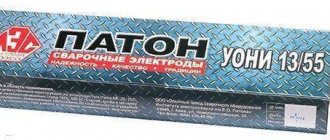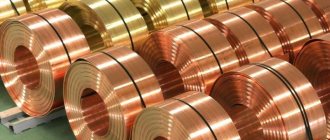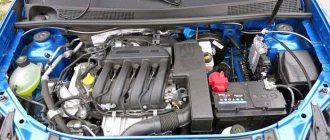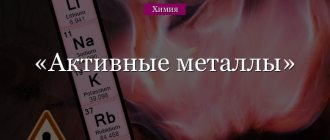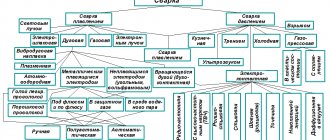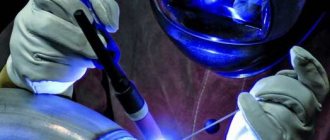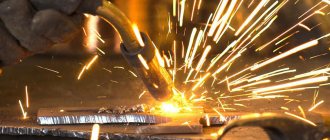The connection made by welding is permanent
, that is, it cannot be disassembled without breaking the part. During monolithic welding, the macromolecules of the parts being joined move from one welded element to another according to the principle of interaction force.
Using welding to connect parts, it is enough just to bring the elements being welded together to such a distance that the interconnection force appears. A bond also occurs between the polymers being welded, the interface disappears, and welding occurs.
Welding as a technological process is a permanent connection of product elements, which is based on the diffuse and chemical interaction of polymer macromolecules. The result of such processes will be the disappearance of the interfaces between the connected surfaces.
But even if the surfaces being connected have a perfectly smooth surface, then various interferences in the form of contaminants and adsorbed gases will prevent such rapprochement, therefore it is necessary to use energy carriers from the outside: deformation and heat. The energy of deformation helps to overcome the repulsive force that appears between the atoms of the approaching surfaces. Thermal energy is aimed at increasing the development of interaction between surfaces. There are two main processes in the welding zone:
- Supply and energy conversion;
- Transformation of substances.
Depending on the intensity of welding and energy conversion, its type will be determined.
Welding requires activation of the surfaces that need to be joined together
. This can be done by supplying energy or converting it. The use of special auxiliary substances is only necessary for certain methods of welding polymers. For example, when welding with heated gases using additive material, as well as when using the melt welding method.
Some types of welding involve significant movement of substances, which in turn is caused by mixing and diffusion in the polymer, brought to a viscous fluid state. The chemical reaction of the active groups of the surface being welded is a special type of movement. Such groups react with each other or interact with the active elements of the intermediate substance. Similar reactions occur during the supply of energy from different types of chemical welding. From the thermodynamics point of view, it can be argued that there is no particular difference between the connection of polymer and metal parts. This definition can be formulated as follows: welding is a method of creating a monolithic connection of parts due to the introduction or thermodynamic irreversible transformation of energy and matter in the area being connected.
The essence of polymer welding
Among all types of parts connections, welding is one of the most economical and reliable methods.
For plastic products, this statement is also fully applicable. Welding, as a rule, produces products of good quality, strong, and durable. Moreover, the process itself can take place both in industrial conditions and in conditions of handicraft production or a private household. There are several different types of plastic welding, but they all share a common essence. In one way or another, the polymer is heated, its macromolecules begin to move, and the polymer components diffuse into each other, followed by obtaining a common monolithic product.
Not all plastics, nor all other materials, are suitable for the welding process. It is mainly suitable for thermoplastics - polymers that can be processed repeatedly by heating, shaping and cooling. Thermoplastic materials, unlike thermosetting plastics, have properties that are more suitable for the process under consideration. At elevated temperatures, thermoplastics come to a plastic state and become suitable for the technology in question.
Welding polymers has a number of undeniable advantages over other methods of joining parts, for example, fastening, adhesive, etc. With its help, you can obtain a smooth, defect-free weld with an even distribution of internal stresses.
Rice. 1. Resistance butt welding.
Weldability of plastics
The weldability of plastics characterizes the suitability of the material to form a permanent joint with a rational technological process.
Depending on the properties of polymer materials, the mechanism for forming a permanent connection can be of two types:
- Diffusion-rheological;
- Chemical.
1. The diffusion-rheological process of interaction between welded surfaces is most effectively implemented in the stage of the viscous-flow state of the material, when macromolecules acquire maximum mobility and have the lowest packing density. In some cases (in amorphous and partially crystalline polymer materials), loosening of the structure can be achieved by exposing the polymer to solvents. The degree and rate of diffusion depend on the molecular weight of the polymers and the polarity of the macromolecule units. As they decrease, the rate of diffusion increases.
Molecular mass distribution, branching of molecular chains, polarity of molecular units can be characterized by the activation energy of viscous flow and quantitatively assess the weldability of polymers . To the same extent, weldability can be assessed by the temperature range in which the polymer can maintain a viscous-flow state, and by the characteristics of the melt viscosity (Table 1).
Table 1: Criteria for assessing the weldability of thermoplastics
| Weldability | Molar internal energy, kJ/mol | Temperature range of the viscous-flow state,⁰С | Dynamic viscosity of the melt, Pa s | Characteristic thermoplastics |
| Well weldable | 150 | 50 | 102-105 | , , F4M, F-42, F-30, F-2, F-40 |
| Limited weldability | 150-250 | 50 | 105-1011 | PVC, PC, PET |
| Non-weldable | 250-334 | – | 1011-1012 | AC, PVA, F-4 |
The strength of the weld is influenced by the condition of the surfaces of the materials being welded, in particular their:
- pollution,
- degree of oxidation, especially in conditions of high humidity,
- filler concentration.
Cleaning from contamination and degreasing are necessary conditions for high-quality welding.
The rheological welding mechanism promotes the breaking of bonds and the removal of these ingredients from the weld area.
The ability of many thermoplastic materials to arrange macromolecules in an orderly manner (crystallization) ensures, under certain temperature conditions, the restoration of the structure of welds close to the base material.
Acceleration of the cooling process of welds, which is allowed for amorphous polymers, causes loosening of the weld structure in crystalline ones. Welds of crystallizing polymers must cool naturally. The recrystallized structure of the weld material improves the intermolecular interaction along the weld line, increases the packing density of the macromolecules of the weld and improves its mechanical characteristics.
Thus, the factors that determine the optimal course of the diffusion-rheological welding process can be influenced by technological methods, the economic feasibility of which determines their practical application.
2. Chemical welding is based on the formation of chemical bonds between polymer materials. Unlike gluing, chemical welding does not form an independent continuous phase.
Materials that are not amenable to diffusion welding (thermosets, vulcanizations, rare network polymers with a ladder structure) can be joined by chemical interaction of functional groups or using a filler material similar in activity to each of the polymers being welded, while heating and welding pressure create the necessary conditions for the process to proceed, and filler materials contribute to the activation of reactive groups.
The quality of chemical welding is determined by the length, concentration, and mobility of active groups of contacting materials. Technological methods can improve the weldability of labor-weldable polymers. Thus, pre-treatment of the surface of the material with a chemical agent helps to increase the plasticity of the surface layers, and with the help of preliminary mechanical treatment of the surfaces being joined, the less reactive layer of the material is removed.
Welding with a heated tool
This type, also called contact or thermal contact welding, is the simplest of all types of connections of polymer parts. The supply of heat to the surfaces to be joined is achieved through their contact with the heated tool. The contact process is very often used in pipeline technology, the manufacture of vessels and containers, and other plastic products and structures.
The most commonly used method is direct heating, in which the following welding steps are carried out:
— cleaning and heating of the surfaces to be welded with a heated tool pressed against them;
- removal of the tool and compression of the surfaces, exposure for a time determined by the technology in a compressed state.
There is an opinion that the time interval from removing the tool to compressing the surfaces together should be minimal. Otherwise, the strength of the welded joint is reduced due to rapid cooling due to contact of surfaces with the environment. However, in fact, the process of welding plastics is much more complicated and it is technologically correct to take a certain pause before joining the parts. During this time, the areas being welded, unevenly heated by the tool, become more prepared for the diffusion process. The technological pause is usually of the order of several seconds.
In addition to direct heating, the method of indirect heating of plastic and embedded heaters are used. The latter method has become widespread for connecting pipes, usually of large diameter, in the field. A special coupling is placed at the ends of the pipes, into which a heating element is placed in advance. Then, when electricity from a field generator is passed through, the inner layer of the coupling melts and creates a permanent pipe connection.
Fig.2. Connecting pipes with a thermowelded coupling
The most common types of thermal contact welding of polymers are butt and socket welding. Equipment for the butt process is simpler and is used more often.
Devices for soldering into a socket heat up the outer surface of one part, for example a pipe, and the inner surface of another, for example a fitting. Then the parts to be welded are installed on the heated equipment. And after the technological time has been maintained on the equipment (mandrel and coupling), the parts are removed and their connection occurs. This technology is very popular for soldering pipes for cold and hot water supply from random polypropylene copolymer.
Mechanical process of welding polymers and their weldability
The topochemical reaction is characterized by three successive stages:
- I. Formation of contact at the physical level;
- II. Activation of surfaces that are in contact with each other;
- III. Volume development of interaction.
In the first stage, physical contact occurs when pressure is applied to the welding elements. There are types of welding when a “liquid” filler substance
.
In this case, contact can be achieved with little or no pressure. These types of welding include joining parts with heated gases
or
extrusion welding
. Physical contact can be established after heating the welded areas to the temperature at which the parts are usually joined or together with heating. At the stage of physical contact, macro- and micro-irregularities are deformed. During deformation, foreign inclusions in the form of gas bubbles, greasy and oily stains and other contaminants are also removed from the contact areas. Soft polymers and materials with a fibrous structure at this stage become more dense due to a decrease in the thickness of the material.
The surfaces to be welded are activated when the heat increases
, which in turn leads to acceleration of the movement of macromolecules. Heating occurs due to the heat input from the heated welding tool, gas or additive material, as well as through the conversion of other types of energy into heat. Such energy can be mechanical, vibration from ultrasound or friction, high-frequency electric field of a capacitor, electromagnetic field, infrared rays, laser and concentrated light beam.
Welding with the conversion of various energies into heat will have some processes that are characteristic of a particular type of source of this energy. For example, welding with high-frequency current will be characterized by a displacement of the dipoles; introduction and propagation of ultrasonic vibrations; the concentration and appearance of heat from mechanical vibrations are characteristic of the use of ultrasound; absorption of rays - IR welding.
Temperature activation is usually accompanied by deformation, since static and dynamic loads imply the penetration of the tool into the surface of the part that is in contact with it. This is also where the shattered or molten material is forced out of the welded area.
The volumetric development of interaction implies the presence of highly complex physical and chemical processes. The leading role of this stage is played by diffusion, and this theory is called diffusion. In some cases, the basis for the volumetric development of interaction is flow, and such a theory will be called rheological.
Hot air (heated gas) welding
The name of the process “hot gas welding” originally comes from the fact that the air in the first welding devices at the dawn of plastics processing was heated by a gas torch. However, this method was dangerous or low-tech, so later welding machines began to be manufactured with electrical heating. Modern devices are also electric, making it possible to regulate the temperature of the process with high accuracy, but the words about hot gas remain in the designation of the process.
Heated gas joining technology is divided into two types: with the use of filler rod and without the use of filler material.
Hot gas welding is a difficult process. It is used for connecting pipes, plastic plates, profiles and other similar moldings in the manufacture of various products. In this case, the parts to be welded and the welding wire are heated with hot air to process temperature and connected under pressure. Heated air usually comes from the welding die.
Most thermoplastics are suitable for this type of technology, but most often it is used to join polyethylene, polypropylene, polyvinychloride of different hardness, ABS and PMMA (plexiglass). As a rule, with rare exceptions, welding different polymers is not possible. The connection between PVC and PMMA is theoretically possible, but the weld is usually weak.
Other types of polymer welding
Extrusion welding. In this process, the welding material, preferably the same polymer as the part being welded, is fed into the welding area in molten form from a hand-held extruder. This small extruder or heated gun receives a continuous supply of filler material in the form of a rod from a coil.
Fig.3. Working with a manual extruder
Solvent welding. This method consists of a number of technological operations: wetting, a pause to wait for the polymer to swell, contact between surfaces, holding under load. This welding is used for polymers that are not resistant to solvents, usually amorphous thermoplastics.
Friction welding. A method that allows you to obtain a strong welded joint almost instantly and without much expense. Excellent for rotating bodies when connecting in a socket. Typically, one product is rigidly fixed, and the second is put on a mandrel, which is rotated by any drive. Then the second product is moved in the axial direction and connected to the fixed product in a socket. From the resulting friction energy, both parts melt, the rotation stops and the desired connection is formed in a matter of seconds.
